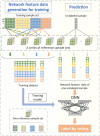Molecular Subtyping of Cancer Based on Distinguishing Co-Expression Modules and Machine Learning
- PMID: 35586568
- PMCID: PMC9108363
- DOI: 10.3389/fgene.2022.866005
Molecular Subtyping of Cancer Based on Distinguishing Co-Expression Modules and Machine Learning
Abstract
Molecular subtyping of cancer is recognized as a critical and challenging step towards individualized therapy. Most existing computational methods solve this problem via multi-classification of gene-expressions of cancer samples. Although these methods, especially deep learning, perform well in data classification, they usually require large amounts of data for model training and have limitations in interpretability. Besides, as cancer is a complex systemic disease, the phenotypic difference between cancer samples can hardly be fully understood by only analyzing single molecules, and differential expression-based molecular subtyping methods are reportedly not conserved. To address the above issues, we present here a new framework for molecular subtyping of cancer through identifying a robust specific co-expression module for each subtype of cancer, generating network features for each sample by perturbing correlation levels of specific edges, and then training a deep neural network for multi-class classification. When applied to breast cancer (BRCA) and stomach adenocarcinoma (STAD) molecular subtyping, it has superior classification performance over existing methods. In addition to improving classification performance, we consider the specific co-expressed modules selected for subtyping to be biologically meaningful, which potentially offers new insight for diagnostic biomarker design, mechanistic studies of cancer, and individualized treatment plan selection.
Keywords: machine learning; molecular subtyping of cancer; multi-classification; network perturbation; specific co-expression module.
Copyright © 2022 Sun, Wu, Yin, Jiang, Xu and Sun.
Conflict of interest statement
The authors declare that the research was conducted in the absence of any commercial or financial relationships that could be construed as a potential conflict of interest.
Figures




Similar articles
-
Molecular Subtyping of Cancer Based on Robust Graph Neural Network and Multi-Omics Data Integration.Front Genet. 2022 May 13;13:884028. doi: 10.3389/fgene.2022.884028. eCollection 2022. Front Genet. 2022. PMID: 35646077 Free PMC article.
-
A novel machine learning-based workflow to capture intra-patient heterogeneity through transcriptional multi-label characterization and clinically relevant classification.J Biomed Inform. 2025 Jun;166:104817. doi: 10.1016/j.jbi.2025.104817. Epub 2025 Apr 9. J Biomed Inform. 2025. PMID: 40216371
-
Colorectal cancer subtype identification from differential gene expression levels using minimalist deep learning.BioData Min. 2022 Apr 23;15(1):12. doi: 10.1186/s13040-022-00295-w. BioData Min. 2022. PMID: 35461302 Free PMC article.
-
Molecular subtyping of cancer: current status and moving toward clinical applications.Brief Bioinform. 2019 Mar 25;20(2):572-584. doi: 10.1093/bib/bby026. Brief Bioinform. 2019. PMID: 29659698 Review.
-
Hormonal Modulation of Breast Cancer Gene Expression: Implications for Intrinsic Subtyping in Premenopausal Women.Front Oncol. 2016 Nov 14;6:241. doi: 10.3389/fonc.2016.00241. eCollection 2016. Front Oncol. 2016. PMID: 27896218 Free PMC article. Review.
Cited by
-
Characterizing Duodenal Immune Microenvironment in Functional Dyspepsia: An AutoML-Driven Diagnostic Framework.J Inflamm Res. 2025 Jul 15;18:9201-9227. doi: 10.2147/JIR.S524791. eCollection 2025. J Inflamm Res. 2025. PMID: 40687153 Free PMC article.
-
MATTE: a pipeline of transcriptome module alignment for anti-noise phenotype-gene-related analysis.Brief Bioinform. 2023 Jul 20;24(4):bbad207. doi: 10.1093/bib/bbad207. Brief Bioinform. 2023. PMID: 37279601 Free PMC article.
-
Phenomics and Robust Multiomics Data for Cardiovascular Disease Subtyping.Arterioscler Thromb Vasc Biol. 2023 Jul;43(7):1111-1123. doi: 10.1161/ATVBAHA.122.318892. Epub 2023 May 25. Arterioscler Thromb Vasc Biol. 2023. PMID: 37226730 Free PMC article. Review.
-
Deciphering the endometrial immune landscape of RIF during the window of implantation from cellular senescence by integrated bioinformatics analysis and machine learning.Front Immunol. 2022 Sep 5;13:952708. doi: 10.3389/fimmu.2022.952708. eCollection 2022. Front Immunol. 2022. PMID: 36131919 Free PMC article.
References
LinkOut - more resources
Full Text Sources

